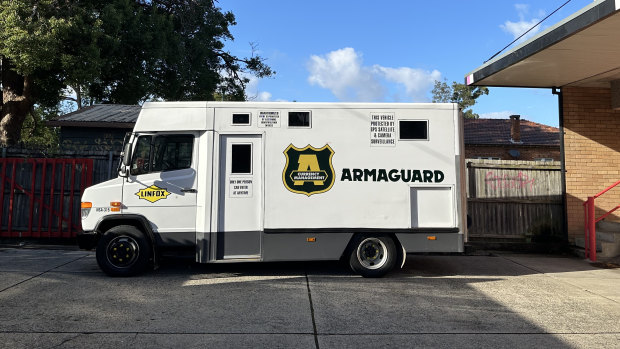Opinion
The Armaguard saga shows we’re a long way from ditching cash entirely
Clancy Yeates
Deputy business editorHave you noticed the recent flurry of stories in the media about the decline of cash?
Financial troubles at the country’s main cash transit business, Armaguard, have highlighted the strain on the infrastructure that ensures ATMs, bank branches, supermarkets and other big retailers are stocked with enough banknotes and coins.

Armaguard’s woes show that as cash payments decline, it is putting pressure on the infrastructure for distributing cash.Credit: Louie Douvis
Some of the more excitable stories have even suggested Australia faced a “cash crisis” or “cash emergency”, after Coles briefly paused Armaguard deliveries and cut withdrawal limits in its supermarkets last week. (Coles reversed these changes after Armaguard received emergency funding from its owner, Linfox.)
In response, banks and the federal government have repeatedly sought to reassure us that there’s plenty of cash out there, so no need to worry. Australian Banking Association (ABA) chief executive Anna Bligh this week went on breakfast television emphasising that we are not about to go cashless, even if we are using much less of the stuff.
So, which one is it? Is cash in serious decline? Or does all the effort to keep Armaguard alive – as well as the contingency planning for its possible demise – show that we still need to have a reliable supply of cash in the community?
I’d say both of those things are true. We’re certainly using much less cash, but we’re also a long way from becoming cash-free.
Balancing these opposing trends will be tricky for banks, big retailers and the government, and eventually, we’ll probably need to make some significant changes to the system we have for distributing cash around the country.
Predictions of a cashless society are nothing new – people have been making them for decades, as electronic payments steadily increased their share.
But there’s no question the slow decline of cash picked up pace during COVID-19, and recent events at Armaguard have added some urgency to the situation.
Late last year, Armaguard revealed its future was at risk from the decline in cash usage. This was a big deal because Armaguard is a vital link in the chain for getting cash to ATMs, bank branches, supermarkets, other big retailers, and post offices. It is also a virtual monopolist, with 90 per cent of the cash transport market, after it was allowed to merge last year with its former main rival, Prosegur.
Big banks last year entered into talks with Armaguard, trying to arrange a rescue package for the company, but last week, Armaguard rejected the banks’ offer. Instead, it opted for a $10 million lifeline from its parent company Linfox, owned by billionaire Lindsay Fox. Banks estimate this will be enough to keep Armaguard operating for a few more months.
This week Linfox told to The Australian Financial Review it would seek to raise prices with banks, but it will need permission from competition watchdog to change a previous undertaking on pricing.
Negotiations will continue, and banks have also started contingency planning for the possibility that a deal can’t be done. But whatever happens to Armaguard, the episode has highlighted that as usage of cash declines, it is putting pressure on the nation’s infrastructure for distributing cash.
The basic problem is that it’s costly to move and store all those notes, and to keep ATMs and bank branches stocked. The costs of trucks, depots and equipment are largely fixed, but there’s less revenue to be made from cash transit because we’re using so much less of it.
Cash was used in about 70 per cent of consumer payments in 2007, but only 13 per cent of payments in 2023, the ABA says. That number will only drop in years to come.
The trend towards digital payments is clear, so the challenges facing cash-handling businesses such as Armaguard are likely to remain.
Yet, at the same time, there are sizeable groups in the community who still use plenty of cash.
The Reserve Bank’s latest survey on consumer payments found 7 per cent of Australians were “high cash users” who use cash for 80 per cent or more of their in-person transactions. While this number halved between 2019 and 2022, the Reserve said people aged over 65 were far more likely to be high cash users than the young. Households with lower incomes also tend to be bigger cash users.
The central bank’s survey also found that for 4.5 per cent of the adult population, cash was essential: they’d experience “major inconvenience or genuine hardship” if they couldn’t access it. When asked why they saw access to cash as essential, these people were most likely to point to security or privacy concerns, followed by the fact some businesses only took cash, followed by budgeting reasons.

People aged over 65 are more likely to be high cash users than the young.Credit: Dominic Lorrimer
Others see cash as a store of value (while in other cases it can be a way to avoid tax, or for criminals to store wealth). The Reserve Bank said last year there was $101.3 billion in banknotes in circulation in the economy – a huge sum, even if it did decline.
There have also been reminders in recent years that electronic payments have their own risks: they are vulnerable to outages, such as in a natural disaster, or if a telco has a technology meltdown.
All up, it’s pretty clear we’re not ready to move to a fully cashless world, even though that’s where more and more payments are heading. But equally, the crunch on the current cash infrastructure is only going to intensify.
As a result, there will almost certainly need to be changes to the system we’ve got for distributing cash to those in the community who still need it.
Perhaps the banks could get together and form some sort of “utility” that shares the cost of distributing cash around the country, a model previously floated by the Reserve, or maybe some other approach will make more sense.
But however the negotiations over Armaguard unfold over the coming months, the system we’ve got now for distributing cash into the community is unlikely to be sustainable in the long term.
Ross Gittins is on leave.
Read more:
- Costs stack up as payments go digital, but some insist we’ll never go cashless
- Scammers are becoming patient: Banks say social media giants need to step up
- Cash to stay: Chalmers vows to keep the notes flowing
The Business Briefing newsletter delivers major stories, exclusive coverage and expert opinion. Sign up to get it every weekday morning.